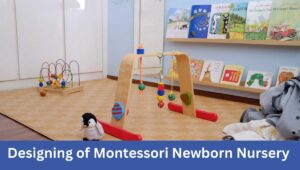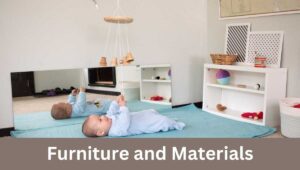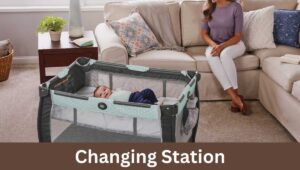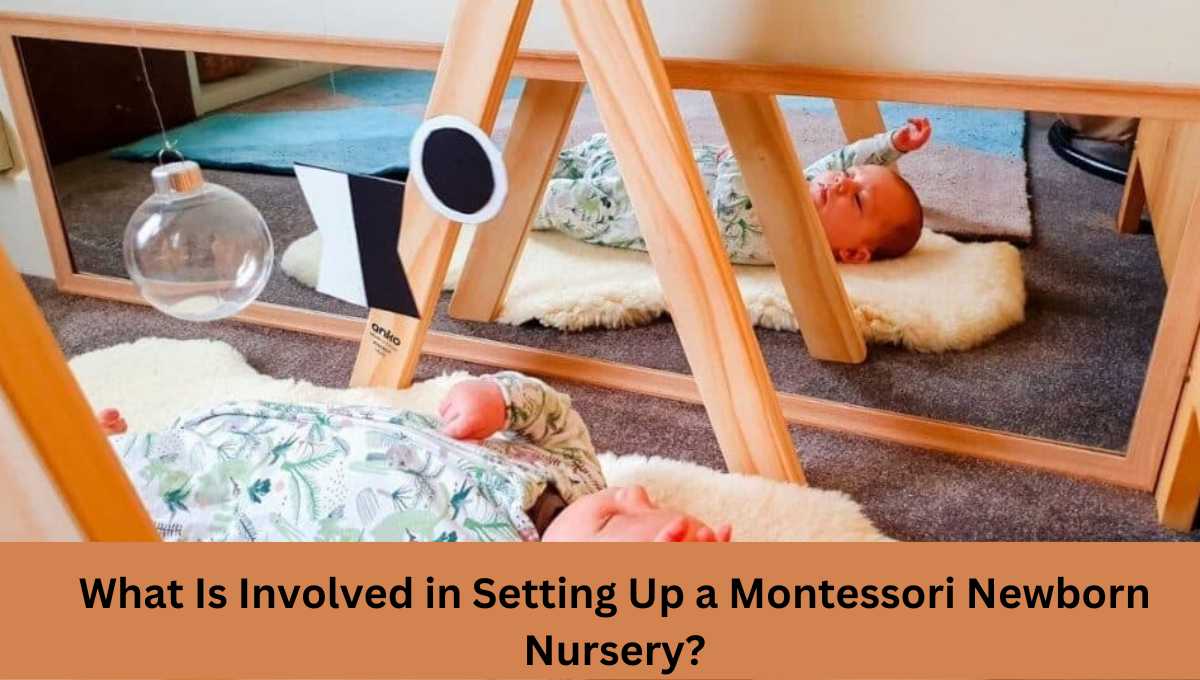What Is Involved in Setting Up a Montessori Newborn Nursery?
Creating a Montessori-inspired nursery for a newborn involves designing a space that fosters independence, exploration, and a sense of calm.
Simplicity and Order
- Keep It Simple: Avoid too many decorations or bright colors. Neutral tones like soft whites, greens, or pastels create a calm atmosphere.
- Declutter: Keep the room clean and free from unnecessary items. A tidy room helps in creating a sense of order.
Furniture
- Low Crib or Bassinet: Choose a crib or bassinet that has a low height. This makes it easy for you to reach in and pick up your baby.
- Comfortable Chair: Place a cozy chair for feeding and bonding with your little one.
Floor Space
- Open Area: Leave enough open space on the floor. This gives your baby room to move and explore.
- Soft Rug or Mat: Use a soft, washable rug or mat for the floor. It’s comfortable for the baby to play on and easy to clean.
Lighting
- Soft Lights: Use gentle, warm lights. Harsh lights can be unsettling for the baby. Consider using dimmable lights to adjust brightness according to the time of day or activity.
Decoration

- Low Shelves: Install low shelves within the baby’s reach. You can place toys and items on these shelves.
- Child-Safe Mirror: Fix a mirror at the baby’s eye level. Babies enjoy looking at themselves and it aids in their self-discovery.
- Simple Mobiles: Hang simple and beautiful mobiles above the crib. Babies find them fascinating and they can be visually stimulating.
Personal Touch
- Family Photos: Display family photos in simple frames at the baby’s eye level. It adds a personal touch to the room.
- Nature Elements: Introduce elements from nature like small potted plants or wooden toys. Make sure they are safe for the baby and out of reach.
Safety
- Childproofing: Secure furniture like shelves and dressers to the wall to prevent tipping. Cover sharp corners and outlets.
- Mattress and Bedding: Choose a firm mattress that fits the crib well. Use lightweight, breathable blankets for the baby’s sleep.
Parent Involvement
- Cozy Seating: Include a comfortable seating area in the nursery. It encourages parents to spend quality time with the baby, like reading stories or cuddling.
Regular Evaluation
- Observe and Adapt: Pay attention to how your baby interacts with the room. As they grow, adjust the room layout to suit their changing needs and abilities.
Furniture and Materials

Low Shelves and Storage
- Open Shelves: opt for low, open shelves that the baby can reach. This allows them to see and choose their toys and activities independently.
- Baskets and Trays: Use baskets or trays to organize toys and items. These containers help maintain order and make it easy for the baby to explore.
Mirror
- Child-Safe Mirror: Install a child-safe mirror at the baby’s eye level. Babies are fascinated by their reflection, and it supports their self-discovery.
Mobiles
- Simple Mobiles: Hang simple, lightweight mobiles above the crib or changing table. Babies love to watch these moving objects, which enhance their visual focus and concentration.
- Natural Materials: Use natural materials like wood and soft fabrics for the mobiles. They are safe and visually appealing.
Soft Lighting
- Gentle Lighting: Use soft, warm lighting in the nursery. Harsh lights can be overwhelming for the baby. Consider using dimmable lights to adjust brightness as needed.
Texture and Sensory Items
- Soft and Textured Toys: Provide soft and textured toys made from natural materials. Babies love to touch and explore different textures, enhancing their sensory development.
- Wooden Toys: Introduce simple wooden toys. They are safe, durable, and excellent for encouraging fine motor skills.
Tummy Time Mat
- Safe and Padded Mat: Create a safe area on the floor with a padded mat for tummy time exercises. Place interesting toys within the baby’s reach to encourage movement and exploration.
Comfortable Seating
- Cozy Chair: Include a comfortable chair for feeding and cuddling. It should be well-cushioned and supportive for both the baby and the caregiver.
Nature Elements
- Potted Plants: Introduce small, child-safe potted plants to bring a touch of nature indoors. Be sure the plants are non-toxic and placed out of the baby’s reach.
- Wooden Decor: Incorporate wooden decor items. Wood has a natural, calming effect and is safe for babies to explore.
Regular Rotation of Toys
- Toy Rotation: Rotate the toys regularly. This keeps the environment fresh and exciting for the baby, encouraging curiosity and exploration.
Practical Life Activities
Changing Station

- Accessible Supplies: Keep diapers, wipes, and spare clothes within easy reach. Use low shelves or drawers for storage.
- Encourage Participation: As your baby grows, involve them in the process. Allow them to reach for items (under supervision) and gradually teach them to undress and dress themselves.
Feeding Area
- Comfortable Space: Create a cozy corner for feeding, whether breastfeeding or bottle-feeding. Use soft pillows and blankets for support.
- Independent Feeding: As your baby starts eating solid foods, introduce simple utensils and dishes that are easy to handle. Encourage self-feeding, even if it gets messy.
Clothing and Care
- Organized Storage: Arrange baby clothes, bibs, and accessories in low drawers or baskets. Labeling drawers with pictures can help your child identify and pick their clothes.
- Dressing Independence: Teach your child to put on simple clothes like t-shirts or socks. Choose clothes with large, easy-to-use buttons or snaps.
Self-Care and Hygiene
- Handwashing Station: Set up a low sink or basin for handwashing. Provide a small, sturdy stool so your child can reach the sink and learn to wash their hands independently.
- Tooth brushing Routine: Introduce a small, soft toothbrush and child-friendly toothpaste. Make tooth brushing a daily ritual, allowing your child to participate.
Cleaning Up
- Child-Sized Cleaning Tools: Offer small brooms, mops, or dusters that your child can use. They love imitating adults and this encourages responsibility.
- Simple Tasks: Teach your child to clean up spills using a sponge or cloth. Praise their efforts to instill a sense of accomplishment.
Mealtime Preparation
- Safe Kitchen Tools: Provide safe utensils like a butter knife and cutting board. Involve your child in simple food preparation tasks like spreading butter on bread or slicing soft fruits (under close supervision).
Gardening Activities
- Planting and Watering: If you have a garden or even indoor plants, involve your child in planting seeds and watering plants. This fosters a connection with nature and teaches responsibility.
Caring for Pets
- Feeding Pets: If you have pets, involve your child in feeding them (under supervision). Teach them about the importance of taking care of animals.
Encouraging Independence
- Patience and Encouragement: Be patient and offer encouragement. Allow your child to do things at their own pace, even if it takes more time.
Safety Considerations
Childproofing
- Secure Furniture: Anchor heavy furniture like dressers and bookshelves to the walls to prevent tipping. This avoids accidents where a child might try to climb and accidentally pull furniture over.
- Outlet Covers: Cover all electrical outlets with safety plugs or outlet covers. Babies are curious and may try to insert objects into the sockets.
- Corner Protectors: Place soft corner protectors on sharp furniture edges to prevent injuries if a child accidentally bumps into them.
Mattress and Bedding
- Firm Mattress: Choose a firm mattress that fits snugly into the crib. A soft mattress can pose a suffocation risk.
- Fitted Sheets: Use fitted sheets specifically designed for the crib mattress. They should fit tightly to avoid entanglement.
Sudden Infant Death Syndrome (SIDS) Prevention
- Back to Sleep: Always place your baby on their back to sleep. This reduces the risk of SIDS.
- Avoid Soft Bedding: Avoid soft bedding materials like pillows, quilts, or stuffed animals in the crib. A simple, firm mattress is safest.
Temperature Control
- Comfortable Temperature: Keep the room at a comfortable temperature, usually between 68-72°F (20-22°C). Avoid overheating or overcooling the room.
- Use Sleep Sacks: If your baby needs extra warmth, use sleep sacks instead of blankets. Blankets can accidentally cover the baby’s face, posing a suffocation risk.
Cord Safety
- Blind Cords: Keep blinds and curtain cords out of reach. Children can accidentally strangle themselves if they get tangled in these cords.
- Electrical Cords: Secure electrical cords to the wall or use cord organizers to prevent babies from pulling on them.
Safe Toys and Materials

- Age-Appropriate Toys: Choose toys that are suitable for your baby’s age. Avoid toys with small parts that can be a choking hazard.
- Non-Toxic Materials: Ensure toys and nursery items are made from non-toxic materials. Babies tend to put everything in their mouths, so safe materials are crucial.
Supervision and Vigilance
- Constant Supervision: Never leave your baby unattended, especially on changing tables or elevated surfaces.
- Be Vigilant: Keep an eye out for potential hazards, such as small objects that your baby could swallow or sharp items within reach.
Regular Inspections

- Check Regularly: Regularly inspect the nursery for any potential safety risks. Babies grow quickly, and what was out of reach one day might be accessible the next.
By paying attention to these safety considerations, you create a secure environment where your baby can grow and explore with confidence, allowing both you and your little one to enjoy peace of mind.
You can also enhance your knowledge by exploring following links.
